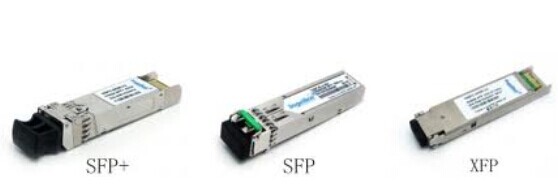
What’s the key difference among the Cisco XFP, SFP and SFP+? SFP, SFP+ and XFP, all refer to a type of transceiver that is plugged into a special port on a switch or to some network device. These transceivers are used in the field of telecommunication and data communication.
XFP (10 Gigabit Small Form Factor Pluggable) is a standard for the transceivers. This type of transceiver is not dependent on the protocol. Generally, it operates at optical wavelenghts corresponding to 850nm, 1310nm or 1550nm. The modules belonging to the XFP are hot swappable which means that the function of replacing the computer system components can be performed without shutting down the system. The specifications of XPF were developed by the XFP Multi Source Agreement Group. XFP complies with the agreement known as XFP MSA agreement.
“SFP” stands for “Small Form-factor Pluggable.” SFP protocol specifications are based on IEEE802.3, SFF-8472. It is most often used for Fast Ethernet of Gigabit Ethernet applications. They are capable of supporting speeds upto 4.25 Gbps. It interfaces a network device motherboard (for a switch, router, media converter or similar device) to a fiber optic or copper networking cable. It is specified by the SFP transceiver multi-source agreement.
SFP+ can be referred to as an expansion of the SFP standard. SFP+ modules are smaller than XFP. It has the capability to support speeds of 10 Gbps or even higher over fiber. The SFP+ product family includes cages, connectors, and copper cable assemblies. It is also similar to the performance requirements of SFF-8431 and also supports 8G Fiber Channel and 10G Ethernet applications. SFP+ comes with various advantages. It is a more compact factor package than compared to that of XFP. The cost of SFP+ is also less than that to the XFP, X2 and XENPAK. And it can connect with the same type of XFP, X2 and XENPAK directly.
What’s the connection between XFP and SFP+? Generally speaking, both of them are 10G fiber optical modules and can connect with other type of 10G modules. The size of SFP+ is smaller than XFP, thus it moves some functions to motherboard, including signal modulation function, MAC, CDR and EDC. XFP is based on the standard of XFP MSA. SFP+ is compliance with the protocol of IEEE802.3ae, SFF-8431, SFF-8432. SFP+ is the mainstream design.
What are the Cisco XFP, SFP and SFP+ in general?
XFP–the first of the small form factor 10GbE optics. Presents LC connectors
SFP–also called mini-GBIC, is upgraded version of GBIC transceiver
SFP+–a 10GbE optics using the same physical form factor as a gigabit SFP. Because of this, many of the small SFP+ based 10GbE switches use 1G/10G ports, giving an added degree of flexibility. Presents LC connectors
XFP, SFP and SFP+ Comparison
| XFP | SFP | SFP+ | |
| Stands for | 10 Gigabit Small Form Factor Pluggable | Small Form-factor Pluggable | Small Form-factor Pluggable plus (standard form) |
| Data rate | 10 G | 155M/622M/
1.25G/ 2.5G/3G/ 4.25G |
6G/8.5G/10G |
| Terms | Dual fiber
Single Fiber/WDM CWDM DWDM |
Dual fiber
Single Fiber/WDM CWDM DWDM |
Dual fiber
Single Fiber/WDM CWDM DWDM |
|
Distance
|
220m/300m/
2km/10km/ 20km/40km/ 60km/80km/ 120km |
300m/2km/
10km/15km/ 20km/40km/ 60km/80km/ 100km/120km/ 150km |
220m/300m/
2km/10km/ 20km/40km/ 60km/80km |
| Wavelengths | 850nm/1310nm/1550nm
1270nm/1330nm 1270nm-1610nm ITU17~ITU61 |
850nm/1310nm/1550nm
1310nm/1490nm/1550nm 1270nm-1610nm ITU17~ITU61 |
220m/300m/
2km/10km/ 20km/40km/ 60km/80km/ 120km |
More Cisco Optical Module Topics
Cisco 10GBASE SFP+ Modules Overview



